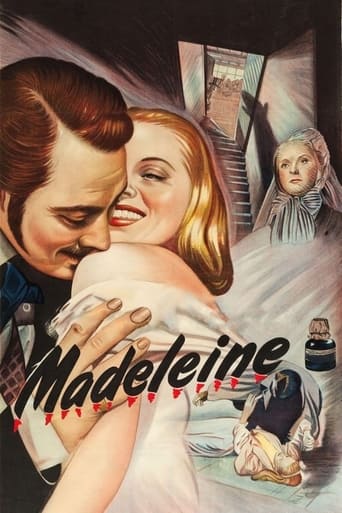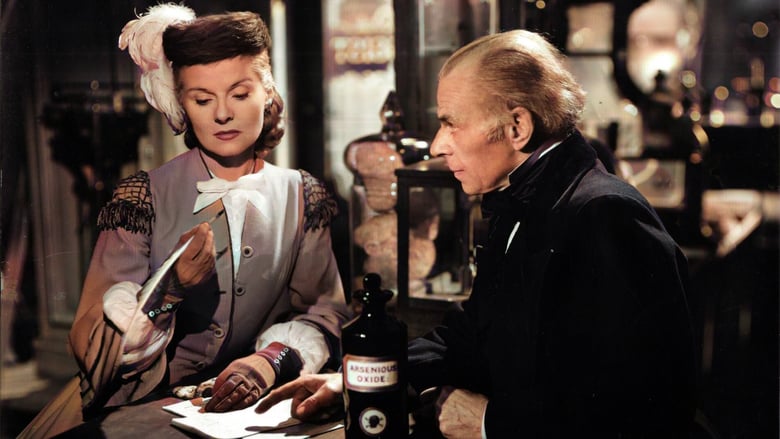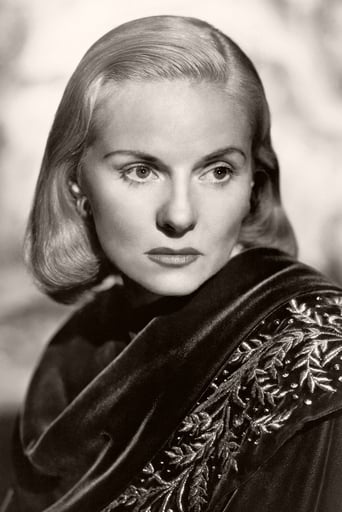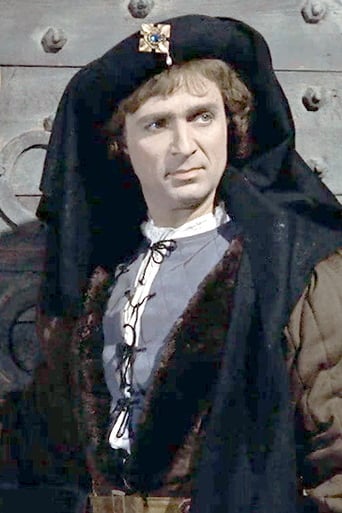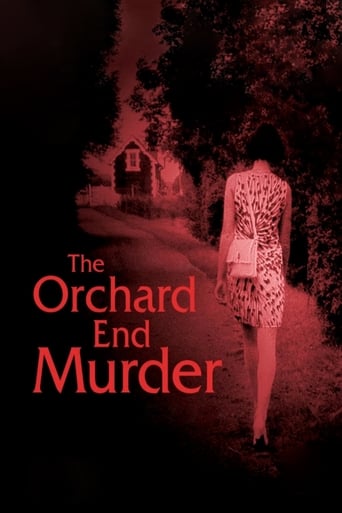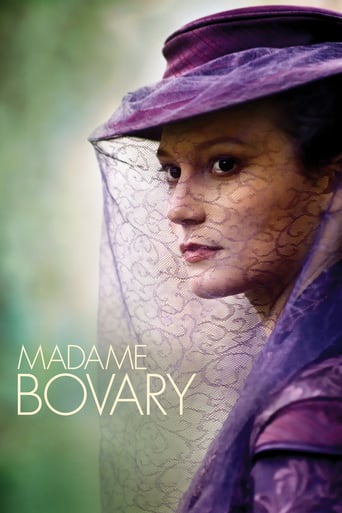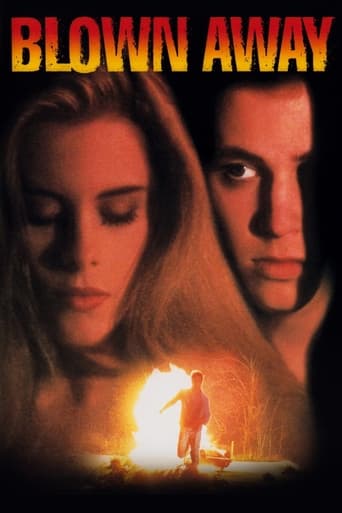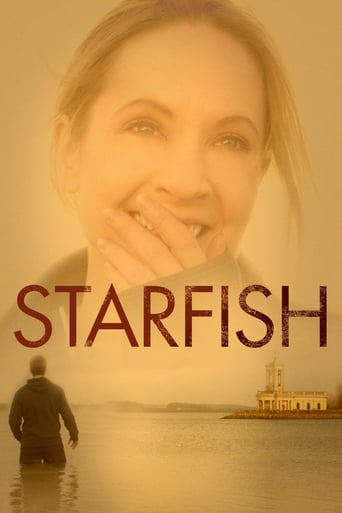Madeleine (1950)
The middle-class family of a young woman cannot understand why she delays in marrying a respectable young man. They know nothing about her long-standing affair with a Frenchman.
Watch Trailer
Cast


Similar titles
Reviews
Wonderful character development!
Simply A Masterpiece
Excellent, Without a doubt!!
An old-fashioned movie made with new-fashioned finesse.
It's 1857 in Glasgow. The city we see on the screen, actually a series of sets, is eerie and a little ominous. It's often night. The streets are cobblestones glistening with recent rain. Gusts of wind scatter the fallen leaves about. The stone buildings seem abrasive. Dark shadows fill the many alleys. It's one of those cities in which anything can happen.There's something strange about the residents too, beginning with the fact that they're called Glaswegians. Ann Todd plays the real-life Madeleine Smith who had a French fiancé, tired of him when she met a new man, who all unwittingly became her second fiancé. Todd wants to marry Number Two, Norman Wooland, but this is a high-class affair and one naturally wants to avoid the kind of scandal that would interfere with one's being invited to the most fashionable soirées.Todd's problem is that fiancé Number One, Ivan Desny, a lively Frenchman, is in possession of a number of love letters from Todd that, by the standards of the early Victorians, were pretty lurid, containing phrases such as "my dearest" and "my bosom heaves with impatience" and certain ribald jokes usually deleted from the diary of Samuel Pepys. (I just made that stuff up, but the letters WERE incriminating.) Todd must get those letters back but Desny seems to be ignoring her importunings. So one day he turns up dead of arsenic poisoning. Todd, who has recently purchased some of the stuff, is taken to trial for the murder. Well, she's not Jack the Ripper but evidently this was a cause celebre at the time.I'd never heard of the movie and I tuned in late, only in time for Desny's death and the trial that followed. But it took only a few minutes to realize that whoever had directed it was showing a good deal of skill in making a movie. Not just those glistening cobblestones but scenes like the prisoner emerging from a trap door just in front of the crowded benches. The end credits revealed David Lean as the director, of course.I was never a big fan of Ann Todd. She's not a poor actress but rarely seems to have made a film worth remembering. The rest of the cast is superb, including Barry Jones as the insinuating, wheedling prosecutor, and Andre Morell as the defense attorney, more forceful than we're used to seeing him. Jean Cadell as the landlady looks flinty and unyielding but overcomes her outward appearance and acts the concerned citizen. And the script is intelligent and dignified. The dialog is of the period -- "I waited, but you came not." But Brits always handle this slightly stylized and elegant speech very well. Americans do it too, but they seem to be working harder at it.
As you will know from reading other reviews this film is based on a true crime from Scotland in the 1850's.The question is: what does David Lean make of this material? At first he seems to be making a study of the repression of women in Victorian society. Madeleine Smith's life at home is dominated by a stern father who expects his daughters to do their duty by him, even changing his shoes! The bars on Madeleine's bedroom windows are a not too subtle symbol of her caged existence. A breath of freedom and excitement seems to come in the form of a lover, but even he just wants to use Madeleine to advance his social position and can be brutal when his ambition is frustrated - he is certainly not a romantic hero. It is interesting that on the two occasions when we can clearly infer he and Madeleine make love (the first time against the background of a Scots ceilidh, which makes for some very erotic imagery), it is done from a position of dominance on his part, he is literally standing over her.The man Madeleine is expected to marry seems honourable and decent, but he too will prove incapable of loving her as a real person - she must be flawless. When the lover turns to blackmail it seems Madeleine has no way out but to turn to poison.Now the film becomes a courtroom drama. Do we want to see Madeleine acquitted or not? Did she poison Langelier? The end of the film answers this question with an enigmatic smile into the camera from Ann Todd (the 'fourth wall' is broken several times in the film).What we are left with, then, is a film which appears to start from a feminist viewpoint, then becomes a romance, then a crime procedural. From being deeply involved in Madeleine's story, we become distant from her when she is charged with murder. Ultimately we don't really care about her fate, and an unsolved crime is always strangely unsatisfying.There are some great moments of cinematography (particularly deep-focus photography) and image-making here, but the film is not quite a satisfying whole, with too many loose ends (her family's reaction, for example; I'm sure 'Papa' was outraged but he still provided the best lawyer he could find) to make a rounded drama.
No need to recap the plot.My favorite scene and arguably the most significant is where Madeleine breaks free into her spontaneous little dance. Note how she's suddenly responding to the foot-stomping liveliness of the community dance, quite a contrast to the confining rhythms of the upper- class ballroom she's used to. This is the "real" Madeleine surfacing outside her upper-class confinement. And once loosened, it's not surprising that seduction follows.The trouble is that from now on she's "damaged goods" according to patriarchal mores of her time. Frankly, the scene reminds me of the raucous music and love-ins of the counter- cultural 1960's, which produced similar effects on straitened middle-class youth. Given her later affiliations (thanks to reviewer Theowinthrop), perhaps the historical Madeleine is an early hippie type reacting to ten confining pounds of petticoated skirt.Except she's no one to mess with. Fortune-hunter Emile has trifled with her affections, compromised her marriageability, and now wants to blackmail her. It's hard for me to believe she didn't rid herself of the bounder, no matter how cleverly director Lean plays with the visual evidence. Besides, who commits suicide with an excruciating substance like arsenic, especially a canny character like Emile. Maybe there wasn't enough evidence for conviction, but the finger of guilt appears overwhelming.The movie itself amounts to a stylistic triumph. Those Gothic early scenes are beautifully staged, as other reviewers spell out. Just as importantly, the expressionism complements the shadowy nature of the illicit romance and likely mirrors Madeleine's joyless inner life. I also like the way actress Todd turns on the spark at the community dance in contrast to her usual cold demeanor. My one reservation is with the abrupt transition from Gothic drama to courtroom procedure. Lean does his best to establish stylistic continuity, but the contrast in tone and direction remains. Then too, I suspect the unresolved ending was not popular with many audiences of the day; at the same time, it's hard to see a Hollywood studio taking the same risk. Nonetheless, the film remains highly compelling despite the non-Parry Mason ending.
David Lean is one of those directors who I don't quite know how to 'take'. Watching the 'lesser' films of a great director (in a great box set I got this year) is no doubt an excellent way to decide what you really think about them. The awe (or boredom) inspired by the best-known and allegedly the best-loved works is absent; you watch with completely open, unaffected eyes. Thus "Madeleine": I knew nothing about the (true) story on which it is based, and was gripped by a thoroughly sinister and tense story from first to last. I won't cover the story - it's been done so well by other reviewers.The best parts of a 'minor' film like this stand out all the more strongly for there being no expectation that you should fall on your knees over it. Where a minor director would direct a film of a true story in stocky, reliable fashion, a great director adds flourishes not merely ornamental that truly raise the film to a greater status. The tension is ramped up more effectively; the bitter consequences of the rash acts more bitter; the harm, the joy, the cause-and-effect more meaningful. Lean's control of sound, vision, story, pace here these mark him out as great and bring to mind at their best the way that Kurosawa tells a story. I'm not comparing them they're so different except in the ways that, as the saying goes, it really is all in the detail.Ann Todd plays the temptress Madeleine and my goodness, what a sharp-faced little thing! As much of greed and spoilt willfulness in her wayward course as of real, true love. That her love cools so quickly when she realises (really, didn't she before?) finally that her lover will only take her WITH her money, means that there's really not that much sympathy with her plight. One look at her lover (and this really should be to the credit of the actor) is enough to tell you that he is vain, dandyish, idle, assuming, selfish and too proud for his own good. One look at her is enough to tell you that she usually gets what she wants despite being at least superficially afraid of her father.The scene where Madeleine dances with her lover in a garden, intercut with scenes of the wild ceilidh going on down the hill, whose music provides her ambiance, is absolutely extraordinary, and reminds me of the masterful use of sound and music displayed in Kurosawa's "The Bad Sleep Well" (particularly, the funeral scene). Lean beat the censors in telling his story the way he did, and he shows great control in his racking up of the tension throughout the story.It's also a real pleasure to see some great Scottish actors that appeared in other films of this period which I adore: Jean Cadell, who appears in "Pygmalion" which Lean edited and "I Know Where I'm Going!", and John Laurie (also in "I Know Where I'm Going!" and in "Major Barbara").The transformation of L'Angelier from ardent, put-upon lover to oppressive, near-blackmailer is nicely done; as is the ambiguity surrounding whether Madeleine did, or did not, poison her lover. You just don't really ever quite believe her absolutely: you know there is ambiguity in everything about her, so that you don't trust her reactions and impressions. The court scenes are well played, and there's a thick tightness to the whole that feels like a short, rich dish, full-flavoured and satisfying. And that's not an impression I ever carried away from Lean's 'great' works. It won't make me rethink those works; it will make me seek out with greater interest than before, more of those works of the 1940s and 1950s which I think might be getting lost in the mists of time as cinema and its troublesome offspring, TV, grow from their infancy of those years, to their virulent, American-flavoured adolescence.

